🔭🌃🌌
🔭🌃🌌

Ocean on the moon Europa
Scientists' consensus is that a layer of liquid water exists beneath Europa's surface, and that heat from tidal flexing allows the subsurface ocean to remain liquid.

Europa's surface temperature averages about 110 K (−160 °C; −260 °F) at the equator and only 50 K (−220 °C; −370 °F) at the poles, keeping Europa's icy crust as hard as granite. The first hints of a subsurface ocean came from theoretical considerations of tidal heating (a consequence of Europa's slightly eccentric orbit and orbital resonance with the other Galilean moons). Galileo imaging team members argue for the existence of a subsurface ocean from analysis of Voyager and Galileo images.

The most dramatic example is "chaos terrain", a common feature on Europa's surface that some interpret as a region where the subsurface ocean has melted through the icy crust.
The thin-ice model suggests that Europa's ice shell may be only a few kilometers thick. However, most planetary scientists conclude that this model considers only those topmost layers of Europa's crust that behave elastically when affected by Jupiter's tides.

The Hubble Space Telescope acquired an image of Europa in 2012 that was interpreted to be a plume of water vapour erupting from near its south pole The image suggests the plume may be 200 km (120 mi) high, or more than 20 times the height of Mt. Everest.
Life?
So far, there is no evidence that life exists on Europa, but Europa has emerged as one of the most likely locations in the Solar System for potential habitability. Life could exist in its under-ice ocean, perhaps in an environment similar to Earth's deep-ocean hydrothermal vents. Even if Europa lacks volcanic hydrothermal activity, a 2016 NASA study found that Earth-like levels of hydrogen and oxygen could be produced through processes related to serpentinization and ice-derived oxidants, which do not directly involve volcanism.

In 2015, scientists announced that salt from a subsurface ocean may likely be coating some geological features on Europa, suggesting that the ocean is interacting with the seafloor. This may be important in determining if Europa could be habitable. The likely presence of liquid water in contact with Europa's rocky mantle has spurred calls to send a probe there.
Missions

Europa Clipper is an interplanetary mission in development by NASA comprising an orbiter. Set for a launch in October 2024, the spacecraft is being developed to study the Galilean moon Europa through a series of flybys while in orbit around Jupiter.

The Europa Lander is a proposed astrobiology mission concept by NASA to Europa, an icy moon of Jupiter. If funded and developed as a large strategic science mission, it would be launched in 2027 to complement the studies by the Europa Clipper orbiter mission and perform analyses on site. NASA's budget for fiscal year 2021 neither mandates nor allocates any funds to the mission leaving its future uncertain.
The objectives of the mission are to search for biosignatures at the subsurface ≈10 cm, to characterize the composition of non-ice near-subsurface material, and determine the proximity of liquid water and recently erupted material near the lander's location.
source
More Posts from Monstrous-mind and Others
🐈🐏🐱🌄🍂🍁
“I woolly wuv your wool”

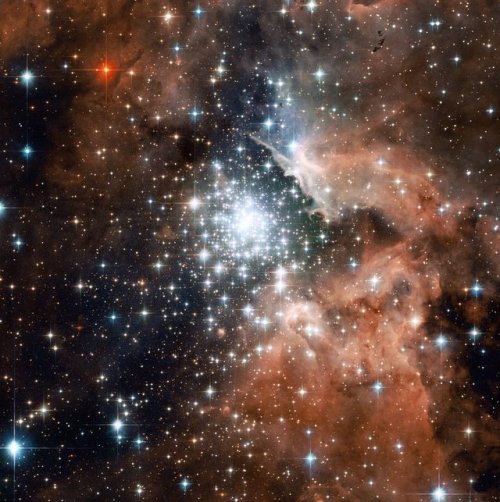
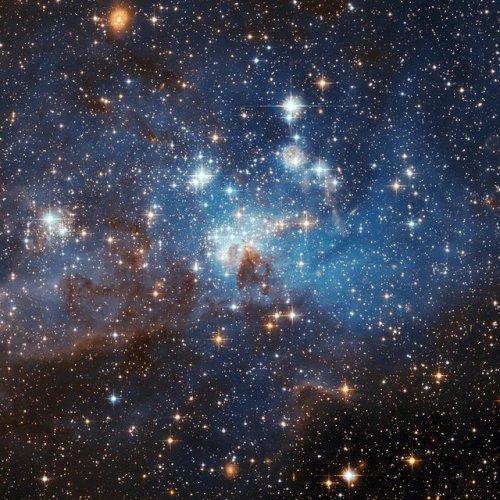
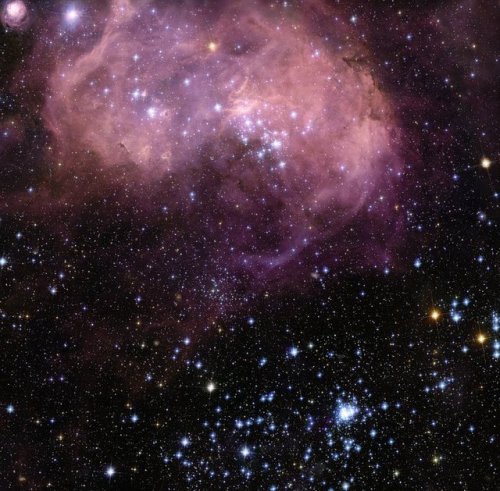
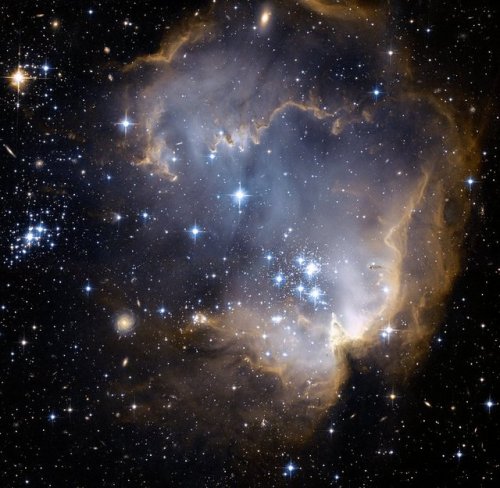
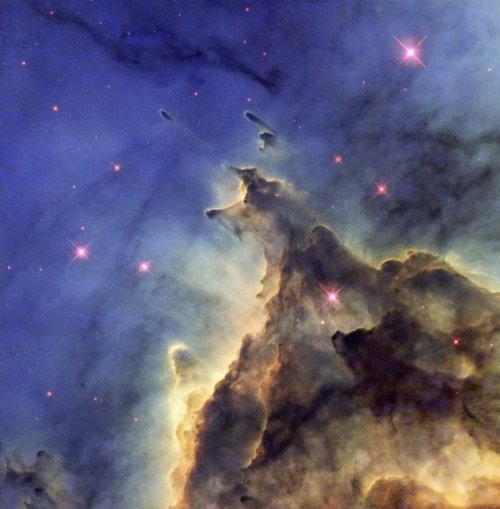
Star-forming regions amid gas and dust taken by the Hubble Space Telescope. (NGC 2467, NGC 3603, Star forming region in the Large Magellanic Cloud (LMC), N11, N90 and NGC 2174)
Image credit: NASA/ESA & Hubble
🛰️🌌🪐☄️🍂🍁

Hubble Sees Possible Runaway Black Hole Creating a Trail of Stars
There's an invisible monster on the loose, barreling through intergalactic space so fast that if it were in our solar system, it could travel from Earth to the Moon in 14 minutes. This supermassive black hole, weighing as much as 20 million Suns, has left behind a never-before-seen 200,000-light-year-long "contrail" of newborn stars, twice the diameter of our Milky Way galaxy. It's likely the result of a rare, bizarre game of galactic billiards among three massive black holes.
The black hole lies at one end of the column, which stretches back to its parent galaxy. There is a remarkably bright knot of ionized oxygen at the outermost tip of the column. Researchers believe gas is probably being shocked and heated from the motion of the black hole hitting the gas, or it could be radiation from an accretion disk around the black hole. "Gas in front of it gets shocked because of this supersonic, very high-velocity impact of the black hole moving through the gas. How it works exactly is not really known," said van Dokkum.
This intergalactic skyrocket is likely the result of multiple collisions of supermassive black holes. Astronomers suspect the first two galaxies merged perhaps 50 million years ago. That brought together two supermassive black holes at their centers. They whirled around each other as a binary black hole.
Credit: NASA

You never forget your first true love...
😮💨📖📚📘📙📗

kitchen ghosts
🌬🍃🍁🍂🎃🍂🍁


Images of Saturn, Tethys, and Mimas taken by Cassini on July 16 2005.
Credit: NASA/JPL-Caltech/SSI/CICLOPS/Kevin M. Gill

Be Glad You Don’t Have to Dust in Space!
Throw open the windows and break out the feather duster, because spring is here and it’s time to do a little cleaning! Fortunately, no one has to tidy up the dust in space — because there’s a lot of it — around 100 tons rain down on Earth alone every day! And there’s even more swirling around the solar system, our Milky Way galaxy, other galaxies and the spaces in between.

By studying the contents of the dust in your house — which can include skin cells, pet fur, furniture fibers, pollen, concrete particles and more — scientists learn a lot about your environment. In the same way, scientists can learn a lot by looking at space dust. Also called cosmic dust, a fleck of space dust is usually smaller than a grain of sand and is made of rock, ice, minerals or organic compounds. Scientists can study cosmic dust to learn about how it formed and how the universe recycles material.

“We are made of star-stuff,” Carl Sagan famously said. And it’s true! When a star dies, it sheds clouds of gas in strong stellar winds or in an explosion called a supernova. As the gas cools, minerals condense. Recent observations by our SOFIA mission suggest that in the wake of a supernova shockwave, dust may form more rapidly than scientists previously thought. These clouds of gas and dust created by the deaths of stars can sprawl across light-years and form new stars — like the Horsehead Nebula pictured above. Disks of dust and gas form around new stars and produce planets, moons, asteroids and comets. Here on Earth, some of that space dust eventually became included in living organisms — like us! Billions of years from now, our Sun will die too. The gas and dust it sheds will be recycled into new stars and planets and so on and so forth, in perpetuity!

Astronomers originally thought dust was a nuisance that got in the way of seeing the objects it surrounded. Dust scatters and absorbs light from stars and emits heat as infrared light. Once we started using infrared telescopes, we began to understand just how important dust is in the universe and how beautiful it can be. The picture of the Andromeda galaxy above was taken in the infrared by our Spitzer Space Telescope and reveals detailed spirals of dust that we can’t see in an optical image.

We also see plenty of dust right here in our solar system. Saturn’s rings are made of mostly ice particles and some dust, but scientists think that dust from meteorites may be darkening the rings over time. Jupiter also has faint dusty rings, although they’re hard to see — Voyager 1 only discovered them when it saw them backlit by the Sun. Astronomers think the rings formed when meteorite impacts on Jupiter’s moons released dust into orbit. The Juno spacecraft took the above picture in 2016 from inside the rings, looking out at the bright star Betelgeuse.

Copyright Josh Calcino, used with permission
And some space dust you can see from right here on Earth! In spring or autumn, right before sunrise or after sunset, you may be able to catch a glimpse of a hazy cone of light above the horizon created when the Sun’s rays are scattered by dust in the inner solar system. You can see an example in the image above, extending from above the tree on the horizon toward a spectacular view of the Milky Way. This phenomenon is called zodiacal light — and the dust that’s reflecting the sunlight probably comes from icy comets. Those comets were created by the same dusty disk that that formed our planets and eventually you and the dust under your couch!
Make sure to follow us on Tumblr for your regular dose of space: http://nasa.tumblr.com
🔭🌌

The clearest image of Mars ever taken!
via reddit
-
 kvethashurtugal reblogged this · 2 months ago
kvethashurtugal reblogged this · 2 months ago -
 kvethashurtugal liked this · 2 months ago
kvethashurtugal liked this · 2 months ago -
 redflamesofpassion reblogged this · 9 months ago
redflamesofpassion reblogged this · 9 months ago -
 atlattacus liked this · 1 year ago
atlattacus liked this · 1 year ago -
 lovelyabstract reblogged this · 1 year ago
lovelyabstract reblogged this · 1 year ago -
 reptilepolice reblogged this · 1 year ago
reptilepolice reblogged this · 1 year ago -
 sanguineblue reblogged this · 1 year ago
sanguineblue reblogged this · 1 year ago -
 glaringmuffingossip liked this · 2 years ago
glaringmuffingossip liked this · 2 years ago -
 azaniacy reblogged this · 2 years ago
azaniacy reblogged this · 2 years ago -
 thenocturnalrush liked this · 2 years ago
thenocturnalrush liked this · 2 years ago -
 zaque-vynne liked this · 2 years ago
zaque-vynne liked this · 2 years ago -
 hellohellopostsnothing liked this · 2 years ago
hellohellopostsnothing liked this · 2 years ago -
 thansry liked this · 2 years ago
thansry liked this · 2 years ago -
 tiredghostpanda reblogged this · 2 years ago
tiredghostpanda reblogged this · 2 years ago -
 tiredghostpanda liked this · 2 years ago
tiredghostpanda liked this · 2 years ago -
 tahwan reblogged this · 2 years ago
tahwan reblogged this · 2 years ago -
 apileofbluestuff reblogged this · 2 years ago
apileofbluestuff reblogged this · 2 years ago -
 citruscrumples liked this · 2 years ago
citruscrumples liked this · 2 years ago -
 sciencestuffforme reblogged this · 2 years ago
sciencestuffforme reblogged this · 2 years ago -
 shirokona reblogged this · 2 years ago
shirokona reblogged this · 2 years ago -
 redlunarash liked this · 2 years ago
redlunarash liked this · 2 years ago -
 imrryr liked this · 2 years ago
imrryr liked this · 2 years ago -
 zurgsoftblog liked this · 2 years ago
zurgsoftblog liked this · 2 years ago -
 dash-n-step reblogged this · 2 years ago
dash-n-step reblogged this · 2 years ago -
 dash-n-step liked this · 2 years ago
dash-n-step liked this · 2 years ago -
 sasuke-shway liked this · 2 years ago
sasuke-shway liked this · 2 years ago -
 tresfoufou liked this · 2 years ago
tresfoufou liked this · 2 years ago -
 just-thinking-about-hogwarts liked this · 2 years ago
just-thinking-about-hogwarts liked this · 2 years ago -
 ventureexpedtion-1933 reblogged this · 2 years ago
ventureexpedtion-1933 reblogged this · 2 years ago -
 ventureexpedtion-1933 liked this · 2 years ago
ventureexpedtion-1933 liked this · 2 years ago -
 problematiquebitch liked this · 2 years ago
problematiquebitch liked this · 2 years ago -
 mellowmakermugpalace liked this · 2 years ago
mellowmakermugpalace liked this · 2 years ago -
 lavvenderskiies liked this · 2 years ago
lavvenderskiies liked this · 2 years ago -
 rothenburgkind liked this · 2 years ago
rothenburgkind liked this · 2 years ago -
 0rchidm4ntis liked this · 2 years ago
0rchidm4ntis liked this · 2 years ago -
 coloursunlimited liked this · 2 years ago
coloursunlimited liked this · 2 years ago -
 istillbelieveinmalebeauty reblogged this · 2 years ago
istillbelieveinmalebeauty reblogged this · 2 years ago -
 memezeek liked this · 2 years ago
memezeek liked this · 2 years ago -
 rochawentsad liked this · 2 years ago
rochawentsad liked this · 2 years ago -
 humdrum-sun liked this · 2 years ago
humdrum-sun liked this · 2 years ago -
 keendaanmaa liked this · 2 years ago
keendaanmaa liked this · 2 years ago -
 imjustexistingtbh reblogged this · 2 years ago
imjustexistingtbh reblogged this · 2 years ago
My ambition is handicapped by laziness. -C. Bukowski Me gustan las personas desesperadas con mentes rotas y destinos rotos. Están llenos de sorpresas y explosiones. -C. Bukowski. I love cats. Born in the early 80's, raised in the 90's. I like Nature, Autumn, books, landscapes, cold days, cloudy Windy days, space, Science, Paleontology, Biology, Astronomy, History, Social Sciences, Drawing, spending the night watching at the stars, Rick & Morty. I'm a lazy ass.
222 posts